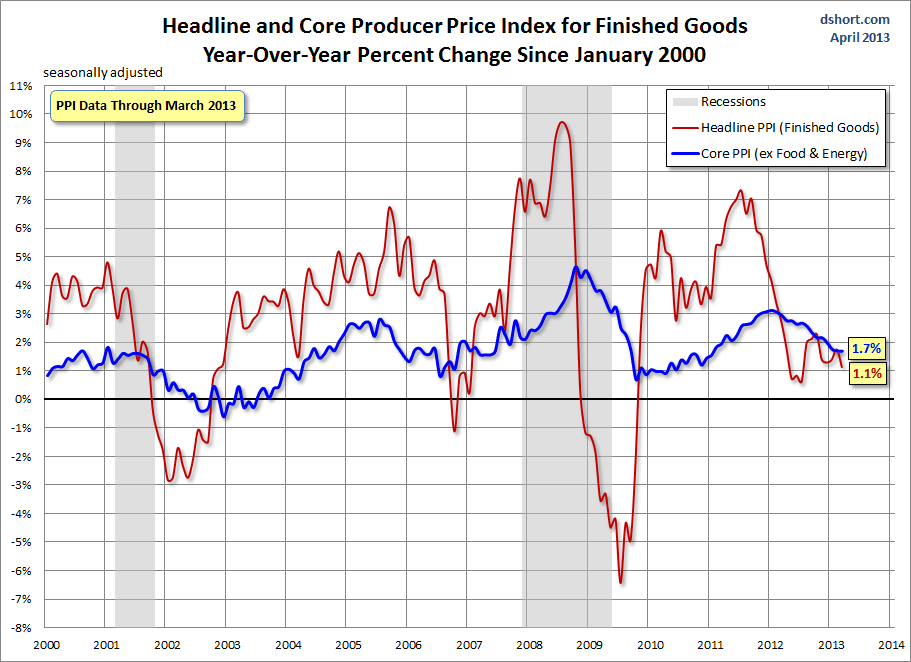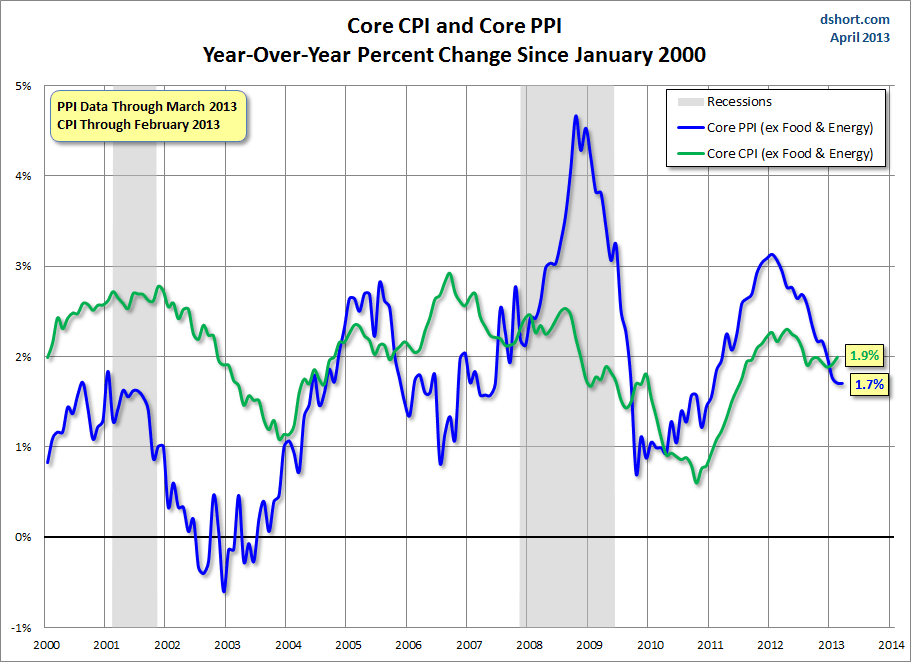Today's release of the March Producer Price Index (PPI) for finished goods shows a month-over-month decrease of 0.6%, seasonally adjusted, in Headline inflation. Core PPI rose 0.2%. Briefing.com had posted a MoM consensus forecast of -0.1% for Headline and 0.1% for Core PPI.
The March decline in Headline PPI follows two months of increases, which had followed three months of declines. Year-over-year Headline PPI is up 1.1% and Core PPI is up 1.7%.
Here is the essence of the news release on Finished Goods:
In March, the decline in the finished goods index is attributable to prices for finished energy goods, which dropped 3.4 percent. By contrast, the indexes for finished consumer foods and for finished goods less foods and energy moved up 0.8 percent and 0.2 percent, respectively.
Finished energy: Prices for finished energy goods fell 3.4 percent in March, the largest decline since a 3.5-percent decrease in February 2010. A 6.8-percent drop in the gasoline index accounted for more than eighty percent of the March decline. Lower prices for diesel fuel and home heating oil also were factors in the decrease in the finished energy goods index. (See table 2.)
Finished foods: Prices for finished consumer foods moved up 0.8 percent in March, the largest advance since a 1.1-percent rise in November 2012. Accounting for nearly ninety percent of the March increase, the index for fresh and dry vegetables surged 21.5 percent. Higher prices for strawberries also contributed to the rise in the finished consumer foods index.
Finished core: In March, the index for finished goods less foods and energy moved up 0.2 percent for the third consecutive month. Almost one-quarter of the March advance can be traced to prices for civilian aircraft, which rose 0.7 percent. More...
Now let's visualize the numbers with an overlay of the Headline and Core (ex food and energy) PPI for finished goods since 2000, seasonally adjusted. As we can see, the YoY trend in Core PPI (the blue line) declined significantly during 2009 and stabilized in 2010, increase in 2011 and then began falling in 2012. Now, in early 2013, the YoY rate is about the same as in early 2011.
As the next chart shows, the Core Producer Price Index is more volatile than the Core Consumer Price Index. For example, during the last recession producers were unable to pass cost increases to the consumer. Likewise in 2010 the Core PPI generally rose while Core CPI generally fell. Since 2012, Core PPI has steadily trended downward and Headline PPI, while remaining volatile, has generally remained below the Core series.
Next week will bring us the more widely followed Consumer Price Index (CPI) inflation indicator.
- English (UK)
- English (India)
- English (Canada)
- English (Australia)
- English (South Africa)
- English (Philippines)
- English (Nigeria)
- Deutsch
- Español (España)
- Español (México)
- Français
- Italiano
- Nederlands
- Português (Portugal)
- Polski
- Português (Brasil)
- Русский
- Türkçe
- العربية
- Ελληνικά
- Svenska
- Suomi
- עברית
- 日本語
- 한국어
- 简体中文
- 繁體中文
- Bahasa Indonesia
- Bahasa Melayu
- ไทย
- Tiếng Việt
- हिंदी
Producer Price Index: Headline Inflation Drops, But Not Core
Published 04/14/2013, 02:21 AM
Updated 07/09/2023, 06:31 AM
Producer Price Index: Headline Inflation Drops, But Not Core
Latest comments
Loading next article…
Install Our App
Risk Disclosure: Trading in financial instruments and/or cryptocurrencies involves high risks including the risk of losing some, or all, of your investment amount, and may not be suitable for all investors. Prices of cryptocurrencies are extremely volatile and may be affected by external factors such as financial, regulatory or political events. Trading on margin increases the financial risks.
Before deciding to trade in financial instrument or cryptocurrencies you should be fully informed of the risks and costs associated with trading the financial markets, carefully consider your investment objectives, level of experience, and risk appetite, and seek professional advice where needed.
Fusion Media would like to remind you that the data contained in this website is not necessarily real-time nor accurate. The data and prices on the website are not necessarily provided by any market or exchange, but may be provided by market makers, and so prices may not be accurate and may differ from the actual price at any given market, meaning prices are indicative and not appropriate for trading purposes. Fusion Media and any provider of the data contained in this website will not accept liability for any loss or damage as a result of your trading, or your reliance on the information contained within this website.
It is prohibited to use, store, reproduce, display, modify, transmit or distribute the data contained in this website without the explicit prior written permission of Fusion Media and/or the data provider. All intellectual property rights are reserved by the providers and/or the exchange providing the data contained in this website.
Fusion Media may be compensated by the advertisers that appear on the website, based on your interaction with the advertisements or advertisers.
Before deciding to trade in financial instrument or cryptocurrencies you should be fully informed of the risks and costs associated with trading the financial markets, carefully consider your investment objectives, level of experience, and risk appetite, and seek professional advice where needed.
Fusion Media would like to remind you that the data contained in this website is not necessarily real-time nor accurate. The data and prices on the website are not necessarily provided by any market or exchange, but may be provided by market makers, and so prices may not be accurate and may differ from the actual price at any given market, meaning prices are indicative and not appropriate for trading purposes. Fusion Media and any provider of the data contained in this website will not accept liability for any loss or damage as a result of your trading, or your reliance on the information contained within this website.
It is prohibited to use, store, reproduce, display, modify, transmit or distribute the data contained in this website without the explicit prior written permission of Fusion Media and/or the data provider. All intellectual property rights are reserved by the providers and/or the exchange providing the data contained in this website.
Fusion Media may be compensated by the advertisers that appear on the website, based on your interaction with the advertisements or advertisers.
© 2007-2025 - Fusion Media Limited. All Rights Reserved.
